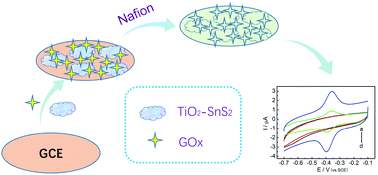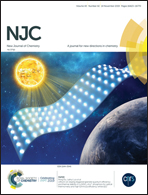A TiO2–SnS2 nanocomposite as a novel matrix for the development of an enzymatic electrochemical glucose biosensor†
Abstract
A titanium dioxide functionalized SnS2 nanocomposite was synthesized for the immobilization of glucose oxidase (GOx) to develop an enzymatic electrochemical glucose biosensor. Scanning electron microscopy, Fourier transform infrared spectroscopy, X-ray photoelectron spectroscopy (XPS) and cyclic voltammetry were used to characterize the nanocomposite and the glucose biosensor. The TiO2–SnS2 composite shows a larger surface area and GOx entrapped in this matrix maintains excellent bioactivity and stability. The constructed glucose biosensor responds to glucose linearly over two concentration ranges of 0.008 to 1.13 mM and 1.13 to 5.53 mM at a working potential of −0.45 V. The biosensor exhibits a high sensitivity (18.9 mA M−1 cm−2), low detection limit (1.8 × 10−6 M) and good repeatability. The present biosensor has excellent selectivity and can be successfully applied for the detection of glucose in serum samples. The advantages of the glucose biosensor show that a TiO2–SnS2 nanocomposite provides a new avenue for immobilizing proteins and fabricating excellent biosensors.



 Please wait while we load your content...
Please wait while we load your content...